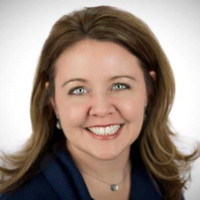Shawnna Sumaoang: Hi, and welcome to the Sales Enablement Pro podcast, I’m Shawnna Sumaoang. Sales enablement is a constantly evolving space, and we’re here to help professionals stay up to date on the latest trends and best practices so that they can be more effective in their jobs.
Today, I’m excited to have Michelle join us. Michelle, I would love for you to introduce yourself, your role, and your organization to our audience.
Michelle Anthony: Hi, thanks so much for having me, it’s great to be with you today. I’m Michelle Anthony, the chief revenue officer here at Lee Hecht Harrison, known as LHH, and we’re part of the Adecco group. What we do is we help organizations transform their workforces. Historically, LHH has been known as a career transition or outplacement business, but what we have found more and more is that organizations are looking to transform their workforces to be future-proof or ready for the workforce that they need for the future.
We’ve been doing a lot of work to assist organizations, developing new skillsets and new leadership profiles that they need to have the right talent to match their business strategy going forward. We’ve been transforming as we’ve been helping our clients transform. As the chief revenue officer, I have the pleasure of looking after both sales and marketing globally here at LHH.
SS: Well Michelle, thank you so much for making the time for us today. You have a wide range of experience leading teams across the business, and as you mentioned, currently you’re leading both sales and marketing. I’d love to hear from you, Michelle, how has this experience in many types of revenue-facing roles really helped set you up for success as a revenue leader yourself?
MA: Yeah, thanks for the question. I’ve enjoyed a lot of variety in my career, both in sales leadership and in marketing leadership. I think being client-centric and being grounded and serving the needs of clients is really at the heart of good marketing and at the heart of good sales performance. I think that’s what unites us as functions and that’s really where we have a lot of common ground.
Also, I began my career, my formative days as a marketer, my first decade as a marketer, with Dell many moons ago and we were really focused, not only on meeting client needs, but also having a revenue-generating mindset. That really shaped my thinking as a marketer. I’ve always been exceptionally close to clients and exceptionally close to the sales team, even in marketing roles, and have always considered marketing in many ways to be an extension of the sales team. That sales and marketing divide that many people experience or talk about or write about, my experience has been quite the opposite. I’ve always felt that we’ve been one team. One go-to-market team is the framework that I’ve always operated under and was trained under from a very, very early stage. That’s how I approach things here at LHH and I think we’ve been able to grow the team and grow revenue as a result.
SS: That’s fantastic. I think you absolutely have the ideal setup. You’ve also said in the past that you believe sales and marketing have a joint responsibility to deliver value to clients. What are some of your best practices to create alignment between sales and marketing so that they can do exactly that?
MA: Yeah, I think when we’re at our best, we’re co-creating with our clients and we’re uncovering those needs that our clients have that are informing things like our product strategy and our product roadmap. They’re informing our editorial calendar or thought leadership calendar or campaign calendar from a marketing standpoint so that our content that we’re putting out is topical and relevant and adds value to our clients. And then arms our sellers, arms our salesforce with things that are adding value and that are relevant so that they’re showing up in a way that is adding value and that is trusted and helping them build that trust with clients. It’s that dialogue.
Some things that we’ve done to help facilitate that co-creation with our clients are establishing a client advisory board, I know a lot of organizations do this, with some of our biggest clients, some of our best clients, and some prospects as well, so that we can have a good sensing ear for what is really going on. What are their most pressing needs, what are some of the future sensing needs that we can be in front of and help them solve so that we can institutionalize that internally all the way from product development, all the way down through sales enablement. That has really been one of the things that’s added a lot of value across the organization for us.
SS: I think that’s fantastic. Now, I want to pivot back to what you were talking about with regards to LHH and how you guys are helping organizations build a workforce for the future. You recently wrote an article where you said companies should focus on lifelong employability because as you said, technology innovations continued to create this gap between the skills a company needs and the skills that the workforce of today possesses. I’d love to understand from you, how can leaders shift their mindset and really think about helping to develop employees internally?
MA: Yeah, thanks for the question. It’s so timely and topical right now as you’ve mentioned, It’s a bit of a perfect storm, isn’t it, that’s been accelerated by the COVID-19 pandemic. We’re in a world where things have been massively undergoing digitalization with the prominence of artificial intelligence that have only been accelerated because of the virtual nature that we’re living and working in now with the pandemic.
As a result, we’ve got some critical skill gaps in the market. We haven’t been able to re-skill and retrain the talent fast enough, and we have an aging workforce. We’re not able demographically in many countries, in many markets, to refill the supply of talent at a fast enough rate.
Bringing all of these things together, all of these macro trends together, and you have this perfect storm where you have this critical shortage of skills that are needed to do the jobs of the future. As a result, what got you here won’t get you there. The old hiring and firing practices won’t get you the workforce that you need because those jobs can’t be filled with talent readily available on the market because the skills don’t exist in enough supply. What you need to do is you need to look from within, and that’s what the most progressive companies have realized. That’s what the most progressive clients that we work with today are doing. They’re looking from within, and they are retraining and reskilling their own employees to fit these critical roles that they know that they going to need to be a viable business in the future.
We’ve worked with several large organizations, but I’ll just take a large financial services client that we’re working with today. We have assisted them in essentially identifying populations of individuals that have the aptitude to be re-skilled. We also have diagnostics where we can help them predict which jobs are likely to change in skill composition and skill profile in the future 5 years out, 10 years out. So, what does your workforce look like today? What should your workforce look like 5 years from now, 10 years from now? What are the pools of talent that have the aptitude and are likely to be successful in a rescaling intervention? Then, what is the rescaling intervention that’s needed ultimately in order to place those individuals in those future-focused roles?
That is the work that we’re doing actively with clients. One of the examples that I think is really cool is that insurance firms no longer need a lot of actuaries because a lot of that work has been automated through AI. We found out through doing this work in partnership with them that they tend to be really great data security workers. They’re very successful in those re-skilling interventions and it turns out large financial services or insurance providers do need a lot of data security talent in their future workforce. That’s just one example of how we’re working with clients to develop employees internally to be fit for the future.
SS: I think that’s amazing. Now, you talked about how retraining is important, but on its own, it’s not enough to keep employees agile, and sales enablement is often very involved in training and professional development efforts. How can sales enablement practitioners take those efforts a step further to help drive retention?
MA: Yeah, it’s so important, isn’t it? In terms of enablement and retention. What we’re finding right now is that it’s really agility and empathy that tend to be the softer skills that are leading to higher engagement and higher retention rates, especially given the COVID-19 fatigue. I think we’ve all pivoted and we’re all working virtually in this new world and no one really knows what the new normal is going to be. Everyone’s a bit fatigued based on Zoom fatigue or Teams fatigue, whatever your virtual medium is. What we have found in some of the research that we have done, again, in partnership with some of our clients, is that team empathy and team resilience is stronger, It retains better, it has higher engagement and performs stronger than individual resilience and empathy.
What we have done is produced an article that’s out on LinkedIn that was actually co-authored by Keith Ferrazzi and our chief innovation and product officer Mary Claire Race and published in Harvard Business Review. It has some tips on how you build team resilience because that’s ultimately what drives engagement and retention. One of the coolest tips in that article is about your team huddle or your team meeting that you may have on a weekly basis or a bi-weekly basis. I know some sales teams even have huddle up on a daily basis. One of the coolest things that you can do to build some team resilience is just to do a quick temperature check at the beginning of every meeting and say, “Hey, on a scale of one to five today, how’s your energy? Are you a one? Are you all the way up at a five? And what’s driving that?” It just surfaces some really honest and open and safe conversations, and it builds some of that more emotive, more human connection. It’s really powerful, especially for folks who maybe aren’t naturally empathetic leaders because empathy is more of a behavior than a skill for some folks.
That is just a quick tip, a bit of practical advice that will build empathy and ultimately will build resilience and engagement and your team that will lead to higher retention. Perhaps, maybe give that a try.
SS: That’s fantastic. One of the things that sales enablement is often faced with is working with frontline managers because they are often the daily interaction or the daily point of contact into a lot of the folks on the frontline. It’s really important to be able to work with frontline managers in order to be able to drive that agility and that empathy that you were just talking about. How can sales enablement help set managers up for success in empowering lifelong learning amongst their own teams?
MA: Yeah, I think it’s a great question. I know when we talked about it as a sales leadership team here at LHH and within the Adecco group, we institutionalized a couple of things at our sales kickoff and in early February this year that we’re giving a try because I think so much of the learning journey and the learning burden falls on the frontline manager, the first line manager. We were trying to institutionalize a couple of other things to see if that would help increase appetite for learning and the stickiness of the things that we were trying to get adoption on within the entire sales organization.
The first thing we did was try to instill this concept of having a growth mindset and that all of us are always learning all the time. You’re never too old to learn new tricks, so we had an artist come in. Most of us in the professional working world probably think we’re not very good artists, at least I know I’m someone who only can draw a stick figure. We had someone who came into our virtual global sales conference and taught us all how to draw cartoon characters. By the end of the session, we all had these amazing drawings that we shared socially and we all really enjoyed seeing everyone else’s work we were all like, “Oh my gosh, we totally can learn something new.”
Whether it’s cooking or drawing or coming together in a new way and having that aha moment, which is like, “Oh my gosh, I actually can learn something new.” I think it’s important to adopt that learning mindset or growth mindset.
The second thing that we did is we put sellers together, not in their nucleus team, not in their normal sales team. We built some cross-functional teams, and we built these learning cohorts and folks are in their cohorts of six to eight people for the remainder of the year, this year. Every month we have a new learning module, whether they’re learning about a new product or practicing a specific sell skill, or working on prospecting techniques, you name it. They go and then practice that skill with a couple of dedicated 30 minutes slots each month with their cohort in a very safe space. Rather than all of that learning burden sitting with the frontline manager directly, they’re learning from one another in these cohorts.
It’s an experiment for sure. I can let you know maybe if we do a podcast again at the end of the year, this time next year, how that experiment is going, but we’re hoping that the peer-to-peer learning will help institutionalize some of our learning objectives this year.
SS: I love that. And yes, I would love to have you back to tell us how it’s gone. Michelle, I’ve learned a lot in this interview. I want to close with a question circling back to something that you said around the importance of resilience. I would love to close out understanding how leaders can help to basically fuel employee’s motivation and remove the obstacles that are draining the energy or contributing to burnout for them.
MA: Yeah, I know we’re all feeling it aren’t we? I think we all have good days and bad days. I know I speak for myself and certainly my two teenage daughters that I’ve been working alongside as they’ve been homeschooling this past year. I think it really does come down to empathy at the core, especially as leaders.
I have found that I’ve had to put on my calendar as a reminder to make sure, whether it’s a team meeting, whether it’s one-on-ones, that I’m creating time and space just to check in and ask people how they’re doing. And not like, how is work going, but like, how are you doing? How is life? How are things going for you? What can I do to help? What is it that you need for me? Amazing conversations surface. People are dealing with a lot of stuff right now as a result of the pandemic, so I have had to reach out and help my colleagues, my teammates in different ways as a leader than I ever have had to in the past.
One example, I have a direct report who lives alone, and I think not having that social interaction for months on end when we were in the early days of lockdown, not having that daily coffee run that provided some social interaction was really critical to her. I was like, Oh my gosh, I need to send this person some of her favorite cold-brew or I need to do something different, inclined to make sure that this person knows that they’re needed and valued and part of this team and part of this community that we have here.
We’re all part of different communities and making people feel valued and appreciated for the work that they’re doing as part of this community is really important. I think that empathy is needed from our team now more than ever. I think just listening, honestly, and responding on a human level is the best thing that we can be doing.
SS: I couldn’t agree more. Thank you so much, Michelle, for the time today.
MA: You bet, happy to do it. Thanks again for having me. I had a whole lot of fun.
SS: To our audience, thanks for listening. For more insights, tips, and expertise from sales enablement leaders, visit salesenablement.pro. If there’s something you’d like to share or a topic you’d like to learn more about, please let us know. We’d love to hear from you.





